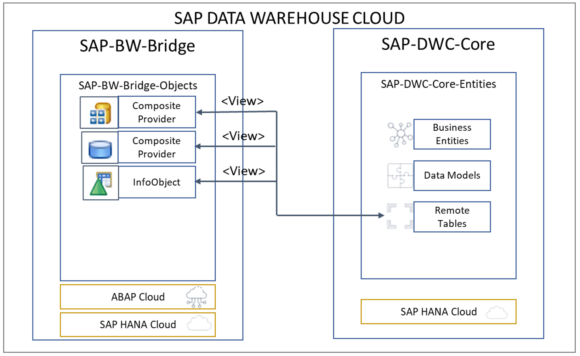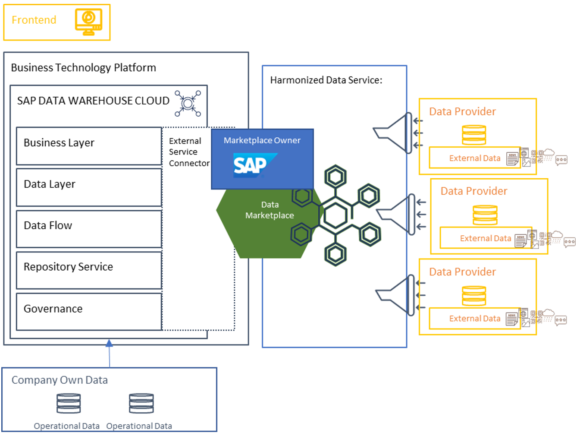With the SAP Data Warehouse Cloud (DWC) and a “cloud-first” strategy, SAP is addressing the need for ever shorter development times and increasing flexibility. However, the high demand for functionalities that connect and further process data from structured integration processes under IT governance and from a wide variety of external data sources is relatively new.
What Challenges Are We Facing?
Many companies share a similar vision when it comes to reporting: to become a data-driven business with a high degree of automation that not only wants to load data using an elaborately structured loading process, but also wants to ensure seamless integration and realize a self-service dashboard. The Business Warehouse Bridge plays an important role in the implementation by facilitating the transfer of data from old structures into new cloud-based warehouse structures. We will present the Business Warehouse Bridge in more detail in this article. But first we will briefly touch on the goals that this development addresses. These are:
- establishing forward-thinking, data-oriented processes and decision making, namely
- by replacing on-premises solutions with scalable, cloud-based solutions.
Reducing Data-to-Value With The SAP Data Warehouse Cloud
The implementation of an individual architecture for the underlying data landscape is often time consuming, since reconciling requirements and business goals takes time. Time is a scarce commodity here, particularly in data and architecture projects. The hope is that SaaS (Software as a Service) offerings and the cloud paradigm will solve this paradox.
The SAP Data Warehouse Cloud (SAP DWC) offers the data warehouse market a strategic public cloud solution, with the focus on agility, consolidation, and time-to-value.
Issues Solved by The Data Warehouse Cloud
Flexibility in integration and consolidation capabilities for business intelligence and business analytics architectures plays an important role in the strategic task of reducing time-to-value for data projects. In the area of data analytics and reporting, two requirements must be fulfilled to enable the provision of consolidated reports:
- comprehensive, meaningful data analyses are only possible when the data pool, which is usually spread across formats and sources, is consolidated, and
- the existing consolidated data pool on specific issues is bundled and integrated.
Currently existing architectural warehousing solutions typically display rigid semantics that are under the governance of an IT(-related) department. This results in corresponding limitations with regard to the adaptability of the architecture: in precise terms, entities are filled via individually created data flows that are based on complex, hard-coded ABAP logic.
Many of our clients are faced with the challenge of ensuring a seamless transition into a new, more flexible warehousing solution; where possible, the existing warehouse architecture should be mapped directly in the Data Warehouse Cloud. In order to be able to consolidate the semantics, individual task areas are shifted to the platform area.
Transferring Individual and Complex Data Warehouse Solutions
In order to transfer complex data warehouse solutions, the data must be prepared and validated. These are tasks for the platform: the Data Warehouse Cloud. This sounds risky and raises questions, such as:
- How does the transition work from a warehouse system whose governance and security rules are complex and have elaborate hard-coded data flows?
- How can data be migrated in the most efficient way, in the shortest possible time, with the lowest possible material costs, from one or more existing data warehouses?
- Could integration potentially mean a loss of operational capability for individual departments?
Data Warehouse Cloud: Use Cases and Benefits in Comparison to The Business Warehouse System
Typically, these are precisely the questions that are discussed and solved individually in workshops with our customers. It is clear that the following architecture requirements pose a particular challenge for our clients:
- the requirement for more freedom during integration of “other” data (types), partly from external sources, as well as
- handling high data volumes, which are consolidated from a variety of systems and applications and must be made centrally accessible for self-service reporting.
The Data Warehouse Cloud is designed with all these requirements in mind. Typical DWC use cases include
- the expansion of existing on-premises data warehouses through the addition of cloud data sources to the existing on-premises data to define new data models for enhanced information content;
- the provision of flexible data marketplaces for monitoring by business users, to ensure that new and agile models can be created on the basis of various sources and the burden on IT departments reduced.
Harmonization: The Data Warehouse Cloud Provides a Consistent View of External and Internal Data Sources
The Data Warehouse Cloud provides functions that enable the connection of data across business applications without duplication. This facilitates a new and consistent view of the data. Ultimately, the DWC provides a scalable cloud platform that can be used to separate rigid business semantics and flexible data integrations. The Data Warehouse Cloud also offers separate spaces for use cases, which require a sandbox approach, such as for the integration of external APIs. With that, it provides many advantages for data management in comparison to the Business Warehouse. The often rigid, inflexible semantics can thus be combined with new use cases.
Conceptual View of The Business Warehouse Bridge
To ensure that the migration of existing data from the Business Warehouse into the target landscape is a success, the Business Warehouse Bridge serves as an enabler.
The Business Warehouse (BW) Bridge expands the capabilities of the SAP Data Warehouse Cloud. This ensures clients, who are using an overgrown SAP BW 7.xNHANA or SAP BW/4HANA for example, have an open path into the Public Cloud.
Functional Explanation of The Business Warehouse Bridge: Transition of Artifacts into The Data Warehouse Cloud
In the transition scenario from Business Warehouse to DWC, the SAP BW Bridge is indispensable. Using the BW Bridge ensures that the transition from BW to DWC takes place seamlessly.
In this way, the SAP BW objects are cloned in the SAP BW Bridge and made available from here as a view for SAP DWC (see Figure 1).

All artifacts needed for data flows and staging functions (data sources, data transfer processes, transformations, aDSO’s, composite providers, process chains etc.) are migrated to a separate SAP BW bridge project in the same development environment. The remote tables that can be created in DWC show the data tables persisting in the bridge and store them in a separate area, the “bridge space.”
Connecting External Data: The DWC Data Marketplace
In this way, the data is available in the DWC and can be further processed with DWC functionalities. Here, for example, loaded data can be augmented with additional data without significant integration work, such as data from manually created REST-APIs (using “custom services”) or data, which can be acquired on the Data Marketplace. In this regard, the strategic function of the DWC Data Marketplace is the provision of an integrated data exchange platform for data providers and consumers. This addresses use cases ranging from external data integration and harmonization to cross-enterprise data-based collaboration between business partners who are using the DWC. Commercial transactions are not currently part of the DWC Data Marketplace. However, embedded license management enables a BYOL (bring your own license) scenario to incorporate data via the SAP store or the sales channel of the respective data provider.

In this way, the entire data exchange between data providers and consumers is decentralized and functions as a bilateral agreement between these two parties. SAP does not save the data, but rather offers a quick and simple communication channel for searching, communicating, and connecting data. The infrastructure of the Data Marketplace thus supports a private, secure, and scalable exchange. Interfaces for open data providers are also present. Consequently, the Marketplace provides the DWC with another important feature for establishing itself as a harmonization and data exchange platform. It creates
- a uniform, standardized data and analysis environment,
- a consolidating and harmonizing data warehousing data marketplace with analytical functions, and
- enables the integration of hyperscalers.
Transition to The Data Warehouse Cloud: a Worthwhile Investment?
The fact that companies are still hesitant about the transition to the Data Warehouse Cloud is understandable. After all, the SAP Data Warehouse Cloud is offering the market the same promise of a highly flexible consolidation solution made by earlier products in the SAP portfolio – ultimately, these have not always been compelling. Some of our clients have complained about significant performance losses, for example, when integrating external systems via MDX interfaces.
The reluctance toward implementing the DWC is also understandable because it is unclear whether a planned or already begun migration to a new data warehousing system (for example, BW/4HANA) is still a logical choice, or whether, as a future-oriented platform, the Data Warehouse Cloud will do away with the Business Warehouse.
SAP BW Bridge is a highly optimized data warehouse solution for the platform SAP HANA. It is used to ensure a seamless transition from an existing warehouse system to a data warehouse cloud and to allow users to easily transfer data flow artifacts, staging objects, and process chains.
This allows clients access to the functions of the data warehouse, while enabling simple consolidation and flexibility with regard to integrating external data.
